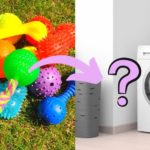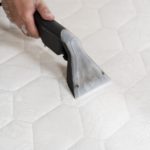You can’t beat a bit of bathtime fun. Rubber ducks have been responsible for more lathered-up larks than you can shake a loofah at.
Indispensable when it comes to persuading children that it’s time for a bath, these toys are every parent’s helping hand.
Playing with them is also enjoyed by the odd grown-up too. (Not just the odd ones either.)
But, in this bitter existence of ours, there’s a price to pay for every bit of fun. In this case, you need to keep those toys clean.
Hang on, you may think, these toy fellas get regular baths. Surely they’ll be super-sparkly, won’t they?
Ah, regrettably not. The problem is that bath toys get wet, then stay wet. Result? Mildew and mould. And nobody likes a mouldy duck.
So, let’s see what you can do about keeping those toys nice and clean.
Mould and Mildew Misery
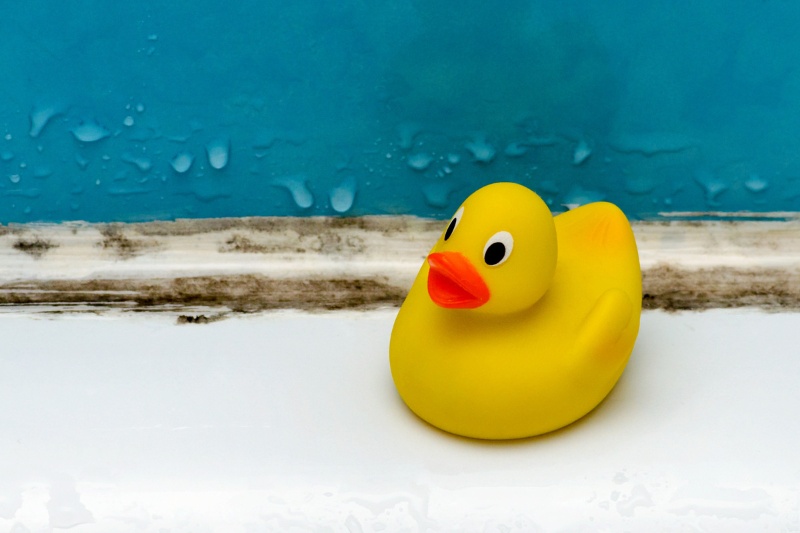
So, the big threats to a bathtime bonanza are mould and mildew, an altogether unappealing kind of M&M. What are they? They’re kinds of fungus, that thrive in warm wet conditions, just like you’ll find in most bathrooms.
What’s the difference between them? Moulds tend to be black, blue and green, whereas mildew is, to re-phrase Henry Ford, any colour you like as long as it’s white.
Mould and mildew are unsightly, but, more to the point, can pose serious health risks. Respiratory conditions and allergic responses can follow exposure to them.
When bath toys tend to be mainly played with by children, it’s easy to see why it’s super-important to keep them clean.
Not only do children have reduced resistance to infection, they also are more likely to put bath toys in their mouths, which is a route one opportunity for health hazards to take effect.
Both mould and mildew tend to be fast-growing and quite tricky to get rid of once they get established. So, the best thing to do is to act before this happens.
You do this firstly by rinsing them in clean water after every bath and keeping them in a net bag, strung up high away from residual water.
Then, once a week, give them a thorough clean. Let’s see how.
Keeping Bath Toys Clean
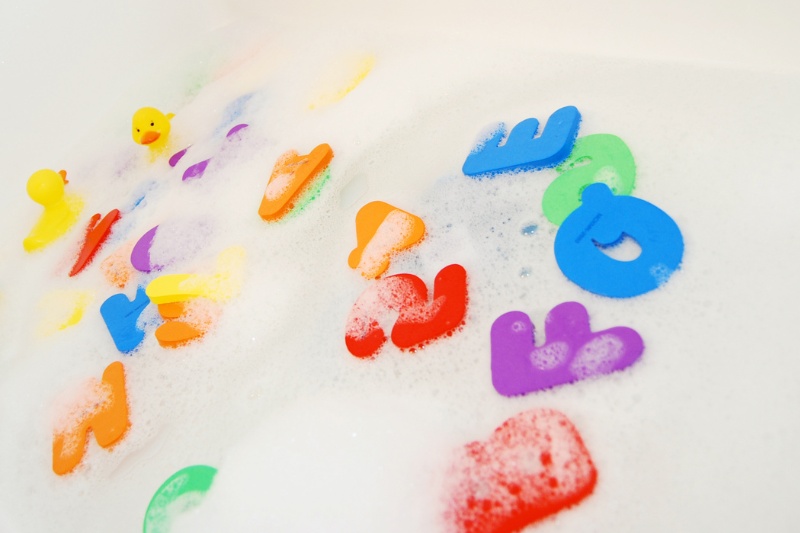
Unless toxic chemicals are your thing, you’ll be glad to know that you can keep your bath toys beautiful with natural household products.
Not only are they non-harmful, they’re usually plentiful. And not too expensive either, so no need to splash out. Baths, see? Splash out! Honestly, I don’t know why I bother.
White vinegar
Fill a bucket with equal parts white vinegar and warm water and dunk your toys in. Leave them in for a few minutes and squeeze them while submerged so the solution can do its thing inside the toys.
When thoroughly vinegared, squeeze the liquid out then rinse the toys in clean cold water and leave outside to dry completely.
It’s crucial to make sure that no trace of moisture is left, so it’s well worth drying al fresco on a fine day if you can.
Boiling water
You can clean most bath toys by dipping them in boiling water. As is well known, water heated to boiling will sterilise against most bacteria, and will do the trick nicely against mould and mildew.
Just be careful not to scald yourself (rubber gloves and laundry tongs are very useful here). Again, be sure to dry properly.
Dishwasher
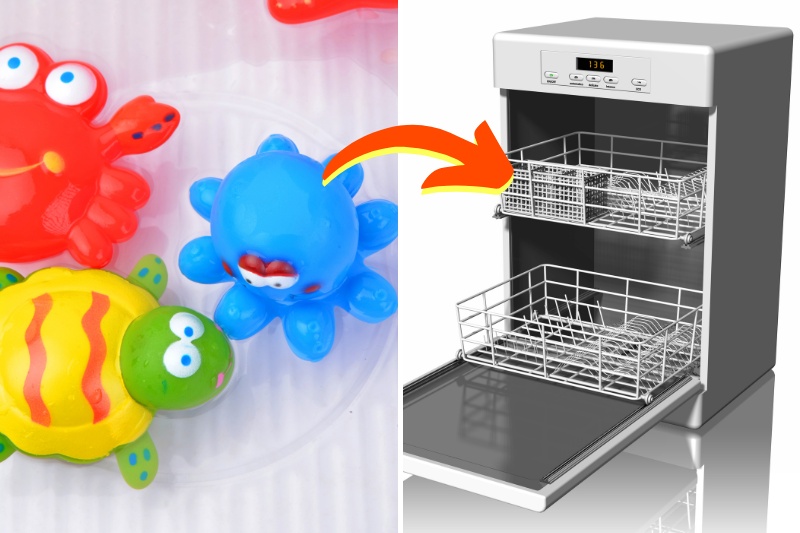
Most bath toys will be fine in the dishwasher. Squeeze them out then put them in the top rack, just to be on the safe side.
Ideally, you want to use a quick, hot wash. When finished, make sure that the toys are squeezed out in the sink and let outside to dry thoroughly.
Washing machine
Stick your tough bath toys in a delicates bag and give them a whirl in the washing machine, at 40° C. If you put a few towels in there too it’ll quieten things down and make the whole business less clanky (technical term).
Tea tree oil
10 drops of this almighty oil in a spray bottle with four cups of water will work wonders. Spray it on and into any hole, and rinse off. Dry thoroughly.
Disinfectant wipe
If you’re pushed for time, this will certainly keep mildew and mould in check on the outside. Won’t do much for the inside though so don’t rely on this method every time.
Sterilising fluid
Use 30 ml of Miltons Fluid in 5 litres of water. Leave the bath toys in for 15 minutes then squeeze out and rinse, then dry.
When Things Turn Serious

If mould and mildew have been allowed to take up residence, it can be really tricky to turf them out. Here are two serious solutions.
Bleach
Sometimes you have to get tough, and things don’t get much tougher than regular (chlorine) bleach.
Use ½ cup in a gallon of water and leave those toys in there for 15 minutes. Again, rubber gloves are the order of the day here, together with goggles and a face mask. Rinse thoroughly and dry as above.
Anti-mould and mildew spray
If, for you, bleach is going too far, then there are other options to consider. Astonish Mould & Mildew Blaster is one of them. It’s vegan, cruelty-free and a little less harmful to the environment than regular bleach.
Mould-Resistant Bath Toys
If all this cleaning lark has you thinking about instituting a shower-only policy in your house, consider this idea: mould and mildew-resistant toys.
There are quite a few available, including whales, dinosaurs, crocodiles, and, for the bathtime play purist, ducks.
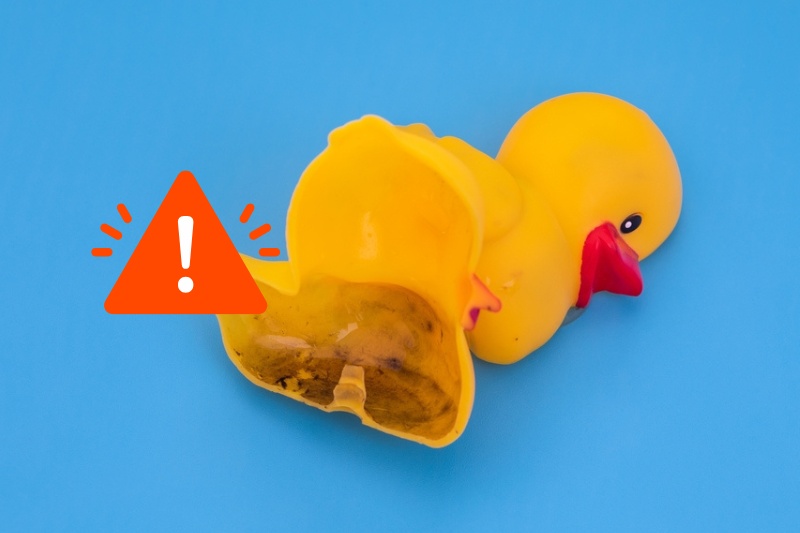
Don’t Toy with that Mould
So, lots of effective options there to get rid of all that thoroughly unpleasant and downright hazardous mildew and mould from your bathtime buddies.
Whichever method you choose, your toys will soon be in tiptop shape and ready for action. Just remember to rinse and dry after every bath and they’ll stay that way a lot longer. Bathtime bliss awaits.

Martin’s life revolves around films, dogs and food, but rarely all at the same time. At least two out of these three like to give clothes and furniture a hard time, and Martin enjoys discovering and writing about new ways to stop them doing their worst.



